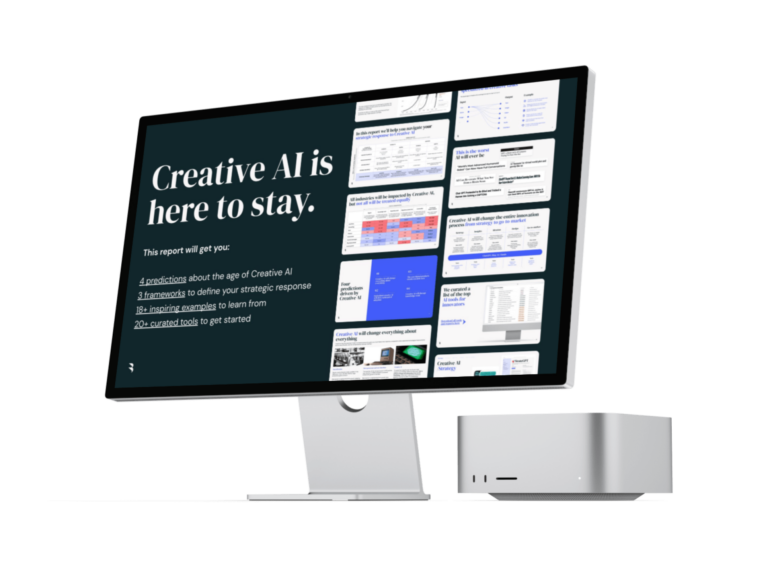AI-powered corporate venture building
Capturing and enhancing the corporate advantage in AI-powered innovation

Managing Director Americas
Corporate venture building today strives to achieve a ‘have your cake and eat it, too’ approach to innovation. Many companies are attempting a hybrid approach towards incubating new growth opportunities by trying to instill cutting edge ‘startup culture’ and bold decision-making within the large, complex structure of a corporation. It’s a mixture of concepts that sounds almost too good to be true, and for many companies, it often is.
Corporate venture building is no simple task. Balancing operational demands with risk-taking is easier said than done. Managing new ventures comes with incredible complexity in decision-making. And the path to innovation is not always bold and exciting – as it’s crucial to balance big picture thinking with day-to-day mundane tasks that are critical to prevent failure or violate legal compliance.
As innovation consultants, we have faced these challenges first hand, including the launch of ventures such as Vanguard’s Digital Advisor and Bayer’s Stem and Root brand in recent years. At Board of Innovation, we have partnered with companies to launch new ventures across many sectors, from logistics, to trade, to financing, to digital nutrition advice. When it comes to delivering successful innovation, we’ve learned that understanding each organization’s unique structure is key and utilizing its unique advantages is essential.
Dive deeper into the topic in our webinar: AI-powered corporate venture building for innovation
Giving corporations the advantage through AI
Integrating ventures into the larger corporate structure relies on finding the sweet spot where the venture can benefit from the corporation’s resources, without being stifled by its processes.
Given recent developments – like the ability to create a GPT-enabled app in minutes, and the continued pressure on and closure of corporate venture building units – you could be forgiven for thinking that corporate venture building is going away and startups and individuals now have exclusive rights on the future of innovation.
We see things differently. The emergence of Generative AI, and the seemingly unlimited types of new business opportunities it is able to create, can give corporations a tremendous advantage in venture building. With the emerging application of AI tools that level the playing field in fast innovation, corporations are in prime position to use their unique strengths in resources and capital to become the world leaders in creating new technologies and products.

6 advancements in AI to power corporate venture building
We are seeing six shifts in corporate venture building that will provide great advantage for corporations:
- Accelerated ‘front-end’ concept development and validation
- AI-powered tools and methods that streamline and de-skill day-to-day activities
- ‘Strategic simulation’ methods to improve complex problem-solving
- New experiences based on human language interaction
- Autonomous products and services that evolve based on real-time data
- Transformative AI-powered business models that create growth for corporations
1. Accelerated front-end concept development and validation
As we’ve previously talked about, AI-powered innovation methods are able to rapidly accelerate the development and validation of hypotheses on new product and service ideas. This can be extended to the use of ‘synthetic testing’ against customer personas and accelerated prototyping with tools like the new Figjam AI.
By using Generative AI tools that can more quickly process company-specific data, corporations can improve their ability to identify and assess growth opportunities that fit their company’s specific capabilities and strategy, and meet the needs of their customers.
2. AI-powered tools and methods that streamline and de-skill day-to-day activities
A lot of the work that goes into corporate venture building is not exciting and bold. It’s the day-to-day work of doing research, testing new features, and product management. The use of new AI-powered methods can streamline these activities while maintaining ‘just enough’ quality to build and grow a new product or idea.
Outset is able to conduct AI-moderated interviews and Kraftful can streamline day-to-day product management activities such as the synthesis of user testing and identification of new features, or the generation of ‘synthetic panels’ of users to provide predictive feedback on decisions.
These applications can help de-skill work and allow corporate venture building teams to manage all of these disciplines quickly, easily, and with less manpower.
3. ‘Strategic simulation’ methods to improve complex problem-solving
A large part of the challenge in corporate venture building comes down to complex decision making and prioritization.
“If we make this decision, what are we giving up on?”
“How will our customers react?”
“How will our internal stakeholders in the core business react?”
These types of questions require complex scenario processing which, even on their best days, humans can have difficulties with. AI won’t replace the role of humans, but it can be used to help humans simplify complex scenarios to make the most informed decisions.
This area is still developing, but we have begun to work with clients to use Generative AI to simulate competitor responses in ‘synthetic wargaming’ exercises. These will allow for the assessment of a variety of complex scenarios that help teams execute a ‘strategic boomerang’ exercise which simulates market feedback without encountering risk.
Corporations in particular can benefit from these simulation methods,as they operate in complex ecosystems and face higher risks based on their decisions.
4. New experiences based on human language interaction
We’re now seeing the start of the disruption of native mobile apps in iOS and Android through new AI-enabled interfaces such as Rabbit and the Humane AI Pin.
This hardware is unique in that it doesn’t require companies to use a design team to help users have a personalized experience. The user verbalizes the assistance they need– whether it’s ordering food, making a restaurant reservation, booking a car share, sending a voice/text message, and more– and the interface will execute the task.
With the emergence of this technology, there will be no further need for users to install and access numerous apps that perform different services. It’s simply done on command, with the commands learned by the AI to help expedite similar future tasks.
Success in these types of experiences will come from having better access to data (and investing in using it to learn what works best), rather than relying on humans to quickly adapt and make decisions themselves – an area where corporations rather than startups have the advantage.
5. Autonomous products and services that evolve based on real-time data
Personalization is nothing new in the digital world. When you log in to Netflix, we see suggestions for different movies and shows on the screen based on what you’ve watched in the past.
This is an example of how products and services can autonomously evolve and personalize themselves to different users. Companies like Netflix will evolve as their AI technology learns more about what features we find most relevant at different times of day and on different devices – not only what we like to watch.
Going forward, some of the most crucial points for driving business will be the volume of data that can be ingested and analyzed, the scale and precision of user audiences that can be used to make decisions, and the governance framework that is deployed to ensure that products and services evolve in a responsible and ethical manner. These are all the domain strengths of corporations, not startups that tend to operate in an ad hoc way by ‘moving fast and breaking things’.
6. Transformative AI-powered business models that create growth for corporations
The true growth opportunities that stem from AI – particularly opportunities that can deliver net positive impacts on climate and society – will take the form of system-wide innovations that enable entirely new business models.
We recently had a major client who wanted to know how Generative AI could better use external data to identify new product ideas for their apparel line. After a bit of exploration aided by AI, we quickly realized a number of opportunities that extended beyond apparel.
AI identified new ways that their company IP could be managed, analyzed the dynamics between suppliers and manufacturers, suggested how to reduce product waste, suggested prevention of trademark infringement, and more. The fact that they are a large, established company already operating across multiple categories means they have tremendous potential for growth in utilizing AI in numerous different areas.
Data is the fuel of AI-powered innovation.
Not ‘hustle’.
Large, complex operational systems are the best playgrounds for applying the strengths of AI, not small groups of people working out of garages.
Let’s not forget that some of the most transformative, industry-shifting business models of the last couple of decades – such as the iPhone and Amazon’s AWS – came from already established corporations, not startups.
With this in mind, in addition to new technologies and products ready to be utilized by large organizations, it’s clear that the emergence of Generative AI is set to shift the advantage to corporations now and throughout the foreseeable future.
At Board of Innovation, we have already begun to apply these new methods to our work in corporate venture building and would love to continue the conversation with you on what you’re seeing and how they could be applied to your business.
If you’re interested in learning more about the future of corporate venture building and how it could apply to your business, get in touch!
We partner with companies to develop real-world functional engines that – starting with simple prototypes that act as co-pilots for human users and building towards autonomous systems that transform product innovation, manufacturing, and go-to-market.


